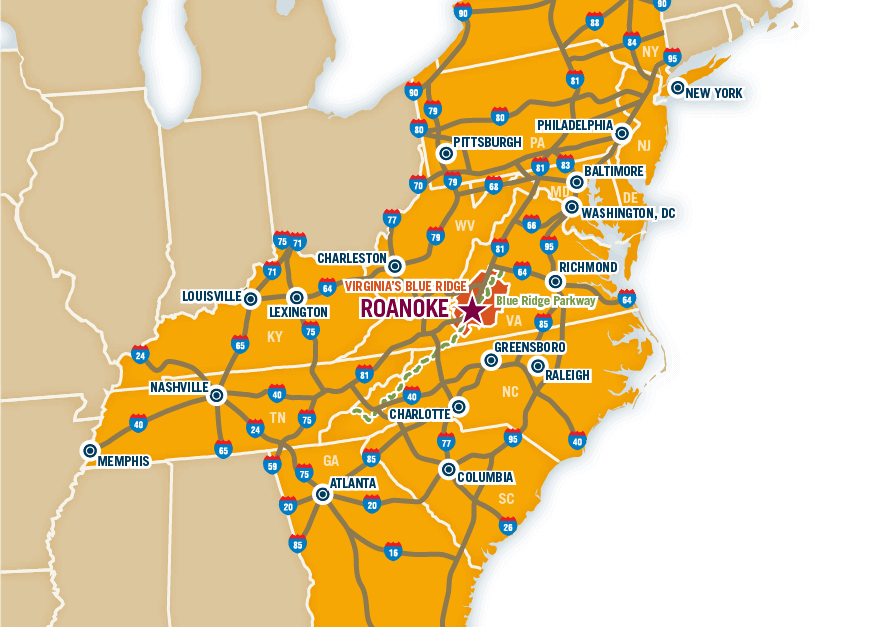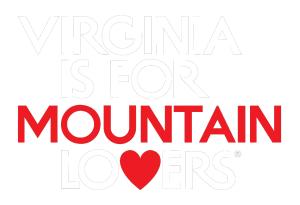-
Things To Do
- Arts & Culture
- Attractions
- Beer, Wine & Spirits
- Blue Ridge Parkway
- Events
- Free Things To Do
- History & Heritage
- Kid Friendly
- Nightlife
-
Outdoor Adventure
- Leave No Trace
- Appalachian Trail
- Biking
- Climbing
- Disc Golf
- Fall Color Spots
- Fishing
- Geocaching
- George Washington & Jefferson National Forests
- Greenways
- Hiking Trails
- Horseback Riding
- Kayaking & Paddling
- Kid Friendly Outdoors
- Motorcycle Touring
- Outdoor Outfitters & Shops
- Scenic Drives
- Water Sports
- Wildlife Viewing & Birding
- Classes & Workshops
- Sample Itinerary
- Sample Itineraries
- Shopping
- Spas
- Sports
- Tours
- VBR Savings Pass
- Hotels/Lodging
- Restaurants
- Region
- Plan
Fast Facts
Click for Virginia's Blue Ridge Statistics
Virginia's Blue Ridge
- Located within a day's drive of 2/3 of the U.S. population
- There are 20 colleges & universities within a 60-mile radius of Roanoke, including Hollins University, Virginia Tech, Radford University, Roanoke College, Virginia Military Institute, and Ferrum College.
- The region anchors the Blue Ridge Parkway, the most visited unit in the National Park System. It is a favored vacation destination and attracts many international visitors who, like others, take advantage of the many opportunities for camping, hiking, picnicking and biking.
- The Greater Roanoke Valley has a population of approximately 300,000.
- Money Magazine ranked Roanoke as one of the "Best Places to Retire in the United States."
- Where else can you experience all four spectacular seasons in the beautiful Blue Ridge Mountains of Virginia?
- Home to part of the George Washington & Jefferson National Forest, including the Appalachian Trail.
- Touches the boundaries of Virginia's 2nd largest lake — Smith Mountain Lake
- Centrally located in downtown Roanoke — the Historic Roanoke City Market — established in 1882, is the longest continuous use farmer's market in Virginia.
- The second largest municipal park in the U.S. — Carvins Cove Nature Reserve
- Roanoke was derived from the Indian word "Rawrenock," a name for the shell beads worn by Native Americans and used as trade goods. Before Roanoke was officially chartered in 1882, the city was known as "Big Lick."
- The region has a significant railroad heritage that is interpreted at the Virginia Museum of Transportation, which is home to the largest collection of diesel and steam locomotives in the United States, including the Class A 1218 and J-611.
- The most visible attraction is the Roanoke Star, a 100-foot-high illuminated steel and concrete structure that's been a beacon at the top of Mill Mountain for more than 60 years. It stands as a "symbol of progress." Check out the overlook from the star by viewing the Starcam.
Roanoke came from the Indian word, "Raw-re-nock," a name for shell beads worn by Native Americans and used as trade goods.
The Appalachian Trail starts in northern Georgia and continues through South Carolina, North Carolina, Tennessee, Virginia, Maryland, Pennsylvania, New Jersey, New York, Connecticut, Massachusetts, Vermont and ends in Maine at Mt. Katahdin in Baxter State Park.
Did You Know? Technically, the United States has only forty-six states. Virginia, Pennsylvania, Kentucky, and Massachusetts are Commonwealths.
The Town of Big Lick was chartered in 1874. It became the town of Roanoke in 1882 and the independent City of Roanoke two years later. Its location in the scenic Blue Ridge Mountains, in the middle of the Roanoke Valley between Maryland and Tennessee, made it the transportation hub of western Virginia and contributed to its rapid growth.
Roanoke became a city so quickly that it earned the nickname "Magic City."
The Mill Mountain Star, also known as the Roanoke Star, is the world's second largest illuminated man-made star, constructed in 1949 at the top of Mill Mountain in Roanoke, Virginia. It was the largest star ever assembled until another was built in El Paso, Texas. However, the Mill Mountain Star still holds the claim to world's largest illuminated man-made standing star, as the one in El Paso lies flat on the ground. The Mill Mountain Star gave the City of Roanoke the title of "Star City" and it has stuck ever since.
Wrestler Tony Atlas is originally from Roanoke, as are twin NFL players Ronde Barber and Tiki Barber, singer Wayne Newton, and actor John Payne. J.J. Redick, former basketball star with Duke University, is also from Roanoke.
"Roanoke" is one of seven communities in the United States with the same name.
Photo via Sam Dean Photography in Botetourt County.Want the latest on Virginia’s Blue Ridge? Securely sign up for our FREE e-newsletter:
Visit Virginia's Blue Ridge 101 Shenandoah Avenue NE Roanoke, VA 24016 (540) 342-6025 (800) 635-5535
Visit Virginia’s Blue Ridge is committed to cultivating an atmosphere that welcomes and celebrates the unique backgrounds, abilities, passions, and perspectives of our vibrant community. As our region’s only destination marketing organization, we have a responsibility to showcase the best the Roanoke Region has to offer, and those assets and strengths come in varied forms. We embrace differences in race, religion, sexual orientation, gender, gender identity or expression, language, visible and invisible disabilities, and all the intersecting identities that make Virginians and visitors alike so unique. We believe our differences make us stronger– and better.







